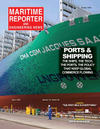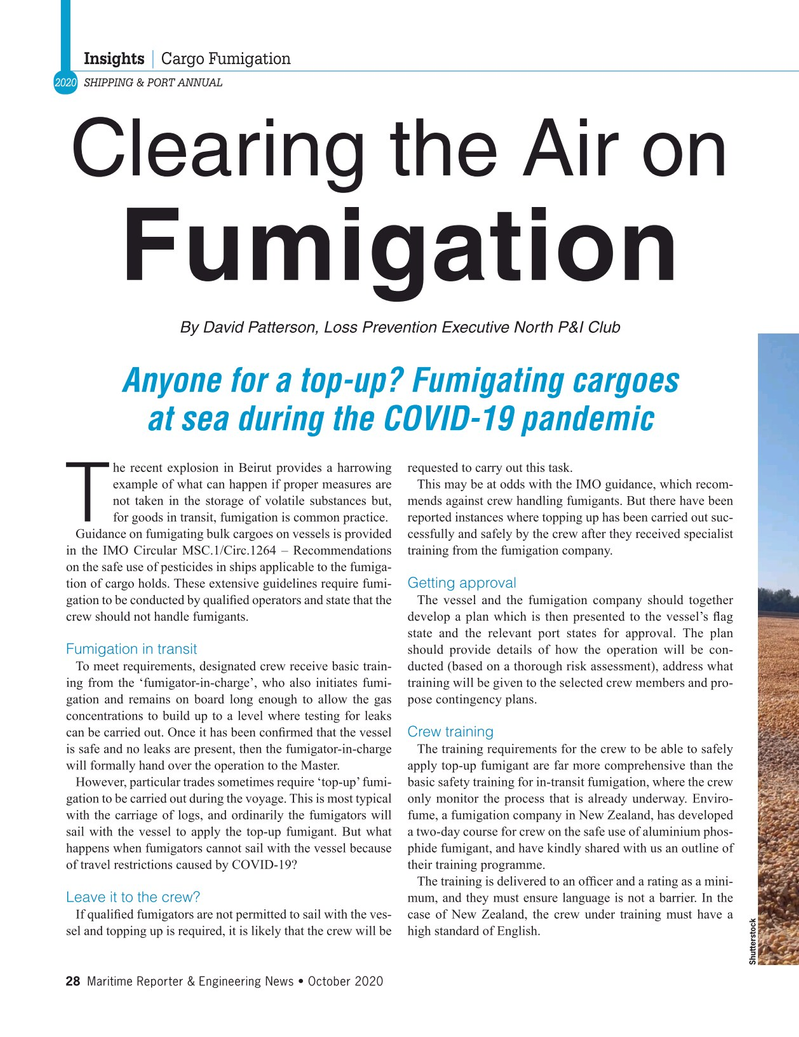
Page 28: of Maritime Reporter Magazine (October 2020)
Shipping & Port Annual
Read this page in Pdf, Flash or Html5 edition of October 2020 Maritime Reporter Magazine
Insights | Cargo Fumigation 2020 SHIPPING & PORT ANNUAL
Clearing the Air on
Fumigation
By David Patterson, Loss Prevention Executive North P&I Club
Anyone for a top-up? Fumigating cargoes at sea during the COVID-19 pandemic he recent explosion in Beirut provides a harrowing requested to carry out this task. example of what can happen if proper measures are This may be at odds with the IMO guidance, which recom- not taken in the storage of volatile substances but, mends against crew handling fumigants. But there have been
T for goods in transit, fumigation is common practice. reported instances where topping up has been carried out suc-
Guidance on fumigating bulk cargoes on vessels is provided cessfully and safely by the crew after they received specialist in the IMO Circular MSC.1/Circ.1264 – Recommendations training from the fumigation company.
on the safe use of pesticides in ships applicable to the fumiga- tion of cargo holds. These extensive guidelines require fumi-
Getting approval gation to be conducted by quali? ed operators and state that the The vessel and the fumigation company should together crew should not handle fumigants. develop a plan which is then presented to the vessel’s ? ag state and the relevant port states for approval. The plan should provide details of how the operation will be con-
Fumigation in transit
To meet requirements, designated crew receive basic train- ducted (based on a thorough risk assessment), address what ing from the ‘fumigator-in-charge’, who also initiates fumi- training will be given to the selected crew members and pro- gation and remains on board long enough to allow the gas pose contingency plans.
concentrations to build up to a level where testing for leaks can be carried out. Once it has been con? rmed that the vessel
Crew training is safe and no leaks are present, then the fumigator-in-charge The training requirements for the crew to be able to safely will formally hand over the operation to the Master. apply top-up fumigant are far more comprehensive than the
However, particular trades sometimes require ‘top-up’ fumi- basic safety training for in-transit fumigation, where the crew gation to be carried out during the voyage. This is most typical only monitor the process that is already underway. Enviro- with the carriage of logs, and ordinarily the fumigators will fume, a fumigation company in New Zealand, has developed sail with the vessel to apply the top-up fumigant. But what a two-day course for crew on the safe use of aluminium phos- happens when fumigators cannot sail with the vessel because phide fumigant, and have kindly shared with us an outline of of travel restrictions caused by COVID-19? their training programme.
The training is delivered to an of? cer and a rating as a mini- mum, and they must ensure language is not a barrier. In the
Leave it to the crew?
If quali? ed fumigators are not permitted to sail with the ves- case of New Zealand, the crew under training must have a sel and topping up is required, it is likely that the crew will be high standard of English.
Shutterstock 28 Maritime Reporter & Engineering News • October 2020
MR #10 (18-33).indd 28 10/6/2020 8:48:17 AM

 27
27

 29
29
